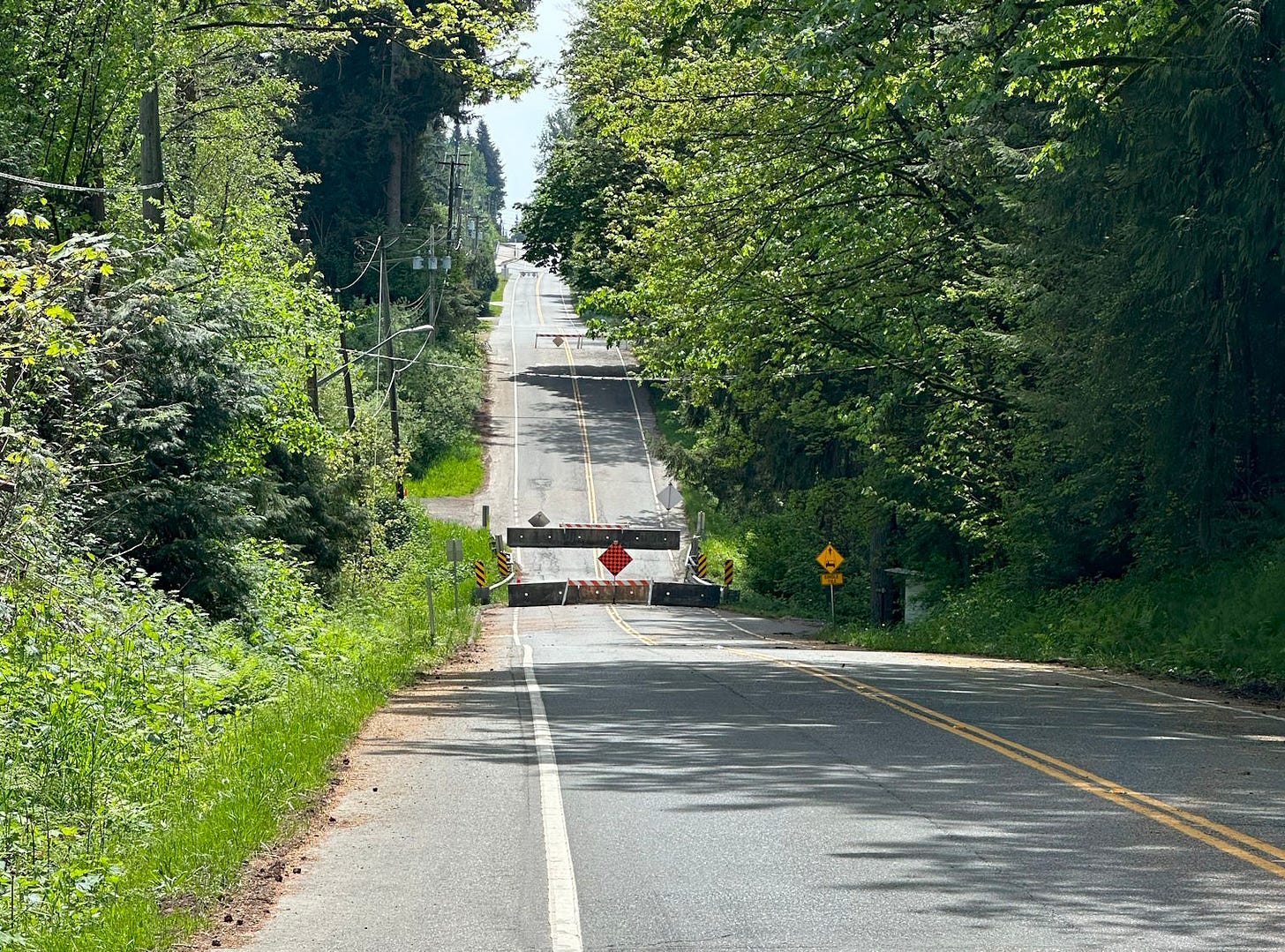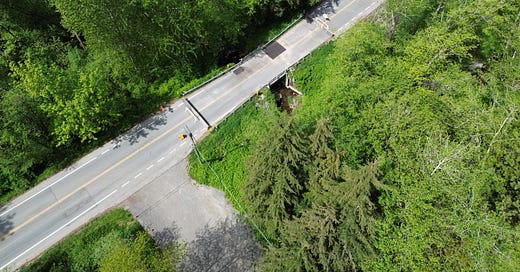On May 1st Mayor Woodward posted on Facebook that the bridge over Coglan Creek on 248th Avenue is in immediate need of replacement and is closed until further notice. Further there are 28 other bridges in the township that also need replacement at the cost of $45M. Previous councils have not saved and invested in this infrastructure leaving the township in a difficult position today.
So how do we do it? What steps do we take to replace these bridges? Well, those questions maybe aren’t the ones we should be asking first. When a bridge, or any asset, reaches the end of its useful life we’re no longer fixing it, we’re making a new investment. The first question isn’t how do we replace this but should we replace this. If it never existed at all would we even be proposing to build it?
We’ve inherited a network of sprawling infrastructure that was built in a time of cheap land, cheap oil and big growth expectations. Today we’re seeing our bill come due. When we replace a bridge we’re not just fixing something we’re making a brand new commitment.
Treat Every Replacement Like a New Build
There’s a powerful political and psychological tendency to treat infrastructure replacement as a neutral act, simply restoring what was already there. But from a fiscal standpoint, replacing a bridge at the end of its lifespan is indistinguishable from building a brand-new one.
This is a textbook case of status quo bias: we assume maintaining what already exists is the default, even when it demands massive new spending. Layered onto this is the sunk cost fallacy, where past investment becomes a justification for future spending regardless of whether the asset continues to deliver value.
In reality the existing bridge is gone, it no longer has value to the township. The question we need to ask is: Would we build it there if it didn’t exist today?
Once we frame it this way many rural bridges, especially those with low usage, high replacement cost and no critical function don’t make the cut.
Time to Triage
This isn’t an argument that it’s time for every bridge to go, but we should be looking at the ones that are at the end of their useful life and triaging them. The politically safe move is to promise to replace all the bridges and treat them as critical investments but the fiscally responsible move is to triage them. Triaging means we make the best use of our limited resources.
Building public support for this approach requires transparency and education. We should clearly communicate the total costs of maintaining all current infrastructure while showing what other township priorities are being delayed or underfunded as a result. Engaging local media to help explain the long-term fiscal benefits will be crucial, as will starting with the least controversial cases to build momentum. By celebrating successes and demonstrating the benefits of reinvesting saved funds, we can frame this as responsible stewardship rather than cuts, helping residents understand that these choices strengthen the township's future.
If we were looking at new bridge infrastructure we’d be expected to model demand, perform a traffic study and justify the investment. Let’s apply that same thinking except we should just go out and measure how many cars use some of these bridges.
Let’s create a simple triage framework that looks at:
Actual traffic volumes on these bridges
Availability and length of alternative routes
Critical access needs like emergency or farm vehicles
Community input from residents and local businesses
From there classify as critical if there is high need, if it provides critical access or if it provides the only access point to a neighbourhood. These are the bridges we will absolutely replace.
If there are low vehicle counts or the bridge provides redundant access, only replace it if the costs are reasonable. We can also consider a one lane bridge for ones that have low traffic volumes.
For other bridges, we should explore a spectrum of options beyond full replacement or removal. Some bridges could be converted to pedestrian/bicycle-only crossings at a fraction of the cost, while others might be downgraded to emergency-access-only structures. We could investigate using lower-cost materials or modular designs for necessary replacements, or develop partnerships with neighbouring property owners on shared maintenance agreements. In areas where winter access is less critical, seasonal bridges might be a viable alternative. For bridges that truly don't justify any investment, we should create a plan to decommission and remove them at the end of their useful life.

When evaluating these decisions, we must also consider broader economic impacts. Decommissioning a bridge could affect farm operations, rural businesses, property values, and development potential. These economic considerations should be quantified where possible and weighed against replacement costs.
This isn't about urban vs. rural. It's about public value per dollar spent. If a $3M bridge serves 25 people with an available detour, but we’re cutting sidewalk budgets or deferring maintenance elsewhere, that’s not responsible, it’s political inertia.
There is an illusion that we can preserve yesterday’s infrastructure without paying today’s prices. In reality, the cost of standing still is millions of dollars we won’t spend on other parts of the township that also desperately need infrastructure.
We also need to consider that the decision to build a bridge 50 years ago didn't take into account the costs of hardening infrastructure against the affects of climate change. A recent Fraser Valley Current article that covers Chilliwack's approach to stream management offers a relevant parallel to our bridge situation. The city is actively "daylighting" streams—bringing pipe-bound waterways back to the surface—not only for environmental benefits but also for fiscal sustainability. Many underground pipes and culverts are failing due to age, with city staff often unaware until sinkholes form or flooding occurs. While replacing these pipes costs approximately $3,000 per meter, opening the watercourse costs just $300 per meter—a 90% savings.
Rather than automatically replacing aging infrastructure, Chilliwack is questioning whether the original design still makes sense. Their evolving policy recognizes that some property owners may wish to maintain the status quo, but places the financial burden of that choice on those who benefit, requiring them to pay the difference between daylighting and pipe replacement. This thoughtful approach balances fiscal responsibility with property rights and community needs—exactly the kind of thinking we need for our bridge infrastructure decisions.
Letting Go Is a Strong Town Decision
We often equate strength with expansion: building more, replacing what breaks, preserving every connection we’ve inherited. But sometimes, strength means restraint. It means recognizing when a piece of infrastructure no longer serves enough public value to justify its cost and being willing to let it go.
Leadership isn’t about preserving everything—it’s about protecting what matters most.
That means facing the uncomfortable truths: not every bridge deserves to be replaced. Not every road needs to exist forever. And not every spending decision made decades ago still makes sense today.
Implementation of this approach would require:
A township-wide inventory and assessment of all bridges, prioritizing those nearing end-of-life.
Traffic counts conducted over multiple days and seasons to capture true usage patterns.
A public dashboard showing the data and preliminary classifications
A phased approach over 5-10 years to allow for budgeting and adjustment.
Annual review of the plan as conditions change.
This work would be led by township engineering staff with oversight from council and regular public updates.
The question facing us isn’t whether we can afford to replace these bridges. The question is whether we should use our limited money this way.
What would a strong town do? It would count cars. It would ask hard questions. And when the math no longer works, it would have the courage to walk away so we can invest in the future instead of preserving the past.
Strong Towns Langley is a community group dedicated to making Langley, British Columbia a better place. We advocate for incremental development, sustainable transportation solutions, housing accessibility, public spaces, and responsible growth strategies. Our group is part of the larger Strong Towns movement, focusing on creating financially resilient and people-oriented communities.
To learn more visit https://strongtownslangley.org




